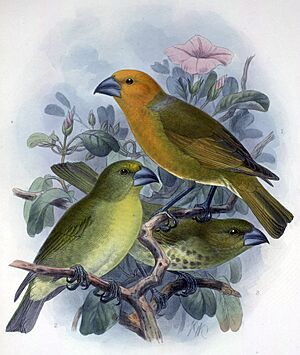Greater koa finch facts for kids
Quick facts for kids Greater koa finch |
|
|---|---|
 |
|
| Specimen | |
| Conservation status | |
| Scientific classification | |
| Genus: |
Rhodacanthis
|
| Species: |
palmeri
|
The greater koa finch (Rhodacanthis palmeri) was a type of finch, a small bird, that lived only in the Hawaiian Islands. Sadly, it became extinct around the late 1800s.
Contents
What the Greater Koa Finch Looked Like
This bird grew to be about 7 to 8 inches (18–20 cm) long. It was the biggest known honey-creeper, which is a group of birds found in Hawaii.
Male and female greater koa finches looked different. This is called sexual dimorphism. The male birds had bright scarlet-orange colors on their head, neck, and chest. Their belly was a lighter orange, and their back, wings, and tail were olive brown with orange hints.
Female greater koa finches were mostly brownish olive. They were a bit lighter in color on their underside. Both males and females had a thick black beak. This strong beak helped them break open tough seed pods from trees.
In the past, these birds mostly lived in the Kona area on the island of Hawaiʻi. They were also seen near Kīlauea in 1895. Before humans arrived in Hawaii, they lived in many more places. Other similar birds lived on different islands too.
What the Greater Koa Finch Ate
The greater koa finch mainly ate seeds. It especially liked the pods and seeds from the koa tree (Acacia koa).
Sometimes, it would also eat caterpillars. It was also seen eating seeds from the ʻaʻaliʻi plant (Dodonaea viscosa).
Why the Greater Koa Finch Disappeared
The last time someone definitely saw a greater koa finch was in 1896. There were a few other reports later, but they were not confirmed.
Like its close relative, the lesser koa finch, this bird lived in small areas of wet forests on the Big Island of Hawaiʻi. These forests were full of koa trees, which were the finch's main food source.
However, starting in 1850, these forests were cut down for wood. The land was then used for cattle pastures. Cows eating the young koa trees stopped new forests from growing.
Also, new animals like black rats (Rattus rattus) were brought to the islands. These rats would eat young birds and their eggs. Diseases like avian pox and malaria, spread by mosquitoes, might have also harmed the birds.
Even before these problems, the koa finches were likely already struggling. Many lowland koa forests were lost, which was their best home. This is why other koa finch types on lower islands disappeared even before Europeans arrived.
See also
 In Spanish: Pinzón koa mayor para niños
In Spanish: Pinzón koa mayor para niños



